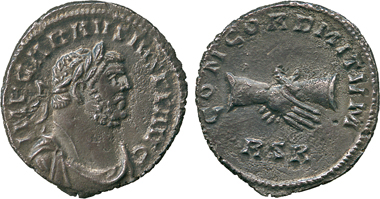07-01-2014 – 01-01-1970
The Aurora Collection
One of The Finest Collections of Roman Gold Coins
Estimated to achieve over $1,000,000, seventy extremely rare Roman coins, many with provenance from well-known collections and important European auctions, will be brought to the market by Baldwin’s, in association with Dmitry Markov Coins and Medals and M & M Numismatics, at the New York International Numismatic Convention on the 8th January 2014.
The coins chart the Roman Empire from the Imperatorial period of the Late Republic to the later Roman Empire, providing a fascinating insight into the social, political and cultural aspects of the era.
33: Estimate. $50,000.
Cloaked in death, deception and imperial propaganda, an exceptionally rare gold aureus, A.D. 200-202, portrays Geta and his older brother Caracalla, the sons of Emperor Septimius Severus (reigned A.D. 193-211).
Although unified by their portrait busts on the two sides of this coin, there was tense rivalry between the two brothers, alluded to by Caracalla’s depiction as Sol, the Sun God, wearing a radiate crown.
Following the death of their father in A.D. 211, the brothers fought to become sole ruler of the Roman Empire, but were jointly declared emperor by the army. A fractious relationship developed that resulted in Caracalla killing his brother at a reconciliation meeting arranged by their mother, Julia Domna. In the aftermath of Geta’s death, Caracalla declared himself Emperor and attempted to eradicate all memory of Geta, executing his wife, children and supporters and removing his image from coinage, paintings and statues. This superb and rare double portrait of medallic quality is estimated at US$50,000.
32: Estimate: $40,000.
Struck in A.D. 215, a gold aureus was a vital propaganda tool in rebuilding Caracalla’s reputation in the wake of the assassination. Shown wearing military uniform, his portrait on the obverse conveys his prowess as a conquering leader, whilst the detailing of the religious scene at the Temple of Vesta on the reverse was designed to emphasise his piety. Although one of the first structures to be built in the Roman-Forum, the Temple of Vesta, as depicted on this coin, still stands in Rome today. Thought by Baldwin’s Ancient coin specialist, Paul Hill, to be “a unique variety of a very rare type”, the coin is estimated at US$40,000.
4: Estimate: $30,000.
A gold aureus with a double-portrait of the deified Emperor Augustus, (reigned 27 B.C.-A.D. 14) and Tiberius on the obverse is an exceptional dynastic issue from the collection. Succession was a significant issue facing Augustus, following the deaths of his trusted heirs, he was obliged to name Tiberius, married to his daughter Julia, his successor and adopted him as his son.
A statement of Tiberius’ legitimacy to the throne, this coin is symbolic of the newly established Julio-Claudian dynasty and the continuation of Augustus’ Roman Empire. Exceptionally preserved and of excellent quality, this coin is a rare treasure from the early Roman Empire and is estimated at US$30,000.
244: Estimate: $10,000.
Dating from the later third century A.D. is a particularly fine silver denarius of the British usurper Carausius (reigned A.D. 286-293). This superb quality coin shows the portrait of the military commander on its obverse, and two clasped hands on the reverse, an interesting piece of propaganda alluding to the harmonious relationship between him and his army.
From the mint of Nicomedia a gold solidus of Emperor Constantine the Great (reigned A.D. 307-337) records a divergence from the traditional style of Roman coins. The portrait of Constantine fills the obverse leaving no space for the usual legend surround.
55: Estimate: $18,000.
Constantine was a revolutionarily leader who converted the Roman Empire to Christianity under his rule. His religious reforms are mirrored in this coin being depicted with his face tilted upwards, looking towards heaven. This uplifted gaze also references the heroic ideals of Hellenistic portraiture celebrated by Alexander the Great, an iconic image that would have appealed to a wide contemporary audience. A remarkable piece of history, it is estimated at US$18,000.
The collection will be offered as part of The New York Sale XXXII alongside an auction of Russian and World coins at the Waldorf Astoria Hotel during the New York International Numismatic Convention.
The catalogue will be available to view online from the first week in December on the Baldwin’s website.








